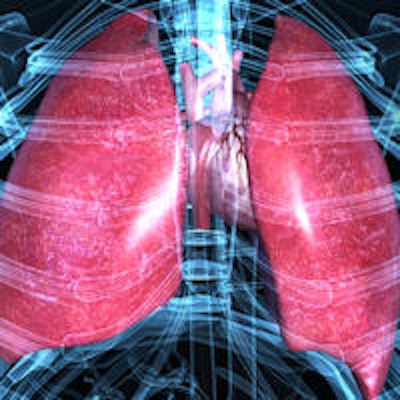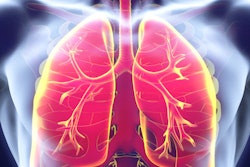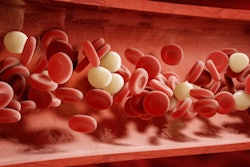
Although it's an extremely rare event, ultrasound exams performed for deep vein thrombosis (DVT) can dislodge blood clots that can then embolize into the vasculature and cause a pulmonary embolism (PE), according to a paper published online in Seminars in Thrombosis and Hemostasis.
In a comprehensive literature review, a multi-institutional and multinational research team found eight original cases in which ultrasound was reported to have caused clot embolization. Radiologists and clinicians need to be aware of this serious and potentially fatal complication and take precautions, according to senior author Dr. Behnood Bikdeli from the Yale University School of Medicine.
"We agree that this phenomenon is rare, but we also have concerns that it is underrecognized and underreported and hope that our study will address this unmet need," Bikdeli told AuntMinnie.com.
Diagnosing DVT
Extremity ultrasonography is by far the most common test for diagnosing upper or lower extremity DVT. There's been a theoretical concern, however, that excessive pressure applied during ultrasound studies may lead to blood clots breaking off and embolizing into pulmonary vasculature, said first author Dr. Ghazaleh Mehdipoor from Shahid Beheshti University of Medical Sciences in Tehran, Iran. Because a quick review of the literature did not support any notions for or against this phenomenon, the researchers sought to investigate this issue in a systematic way.
Other members of the research team included Dr. Abbas Arjmand Shabestari, also of Shahid Beheshti University of Medical Sciences in Tehran, Iran, and Dr. Gregory Lip from the University of Birmingham in Birmingham, U.K., and Aalborg University in Aalborg, Denmark.
The group searched PubMed for all studies between January 1, 1960, and April 10, 2015, that reported possible or confirmed pulmonary embolism as a consequence of extremity ultrasound assessment in patients with suspected DVT. All cohort studies, cases series, and case reports were included in the analysis (Semin Throm Hemost, January 25, 2016).
Of the 3,625 articles reviewed by the researchers, 15 reported on the issue of clot dislodgement and embolization following extremity ultrasound. One was a systematic review that did not find any relevant original reports on the subject, while six were narrative reports that discussed concern over the possibility of extremity ultrasound causing embolization but did not share any original cases.
There were, however, eight original case reports involving seven confirmed PE cases and one probable case from seven men and one woman with an age range of 21 to 75. The first case was reported in 1970, with the last published in 2012. Two of the PE cases resulted in fatalities.
Five of the PE cases were in the right lower extremity and three were in the left. The thrombus was present in the femoral veins in six cases, and four of those were right-sided. Also, thrombus echogenicity was detected in six of the cases, while the other two cases did not provide any information on echogenicity, according to the authors. In two cases, the thrombus was reported to have a free-floating tail.
Six of the eight PE cases were symptomatic, with symptoms (dyspnea, orthopnea, and pleuritic chest pain) occurring within seconds to several hours after ultrasound assessment. In two of the cases, the clot dislodgement was witnessed in the middle of the ultrasound examination.
Compression ultrasound
In all of these PE cases, compression ultrasound was used with or without adjunct technologies, according to the researchers.
"Clot embolization does occur in some cases after ultrasonography," Mehdipoor told AuntMinnie.com. "The time course and clinical characteristics in reports that we found puts it beyond doubt that ultrasound was the causative factor."
The researchers are concerned that clot embolization after ultrasound is underreported, Bikdeli said.
"For example, many of the reports we found about clot embolization after ultrasonography had claimed to have described this phenomenon for the first time," he said.
Another recent systematic review also claimed to have found no relevant cases, whereas the researchers found 15 reports, including eight original cases, Bikdeli said.
Exercise caution
Mehdipoor noted that while the real mechanism for clot embolization after ultrasound is unknown and the phenomenon is rarely reported, use of the compression maneuver during the ultrasound scan was a commonality among the reported cases. As a result, radiologists or sonographers should exercise caution when investigating extremities for suspected DVT, he said.
"It is not necessary to apply excessive pressure for ultrasonographic studies of patients with suspected DVT, and it is prudent to avoid compression or augmentation maneuvers if the thrombus is already visualized on two-dimensional ultrasonography," Mehdipoor said. "Be aware of this ominous, rare complication when the clot disappears during the ultrasound examination."
Mehdipoor said that radiologists, and likewise clinicians, should seriously consider the possibility of a pulmonary embolism if the patient reports less swelling (with or without chest discomfort, tachycardia, etc.) after the ultrasound exam.
The main thing is to be cognizant of the possibility of clot embolization and provide treatment as needed, Bikdeli said.
"If there's evidence of hemodynamic collapse, bedside [transthoracic echocardiography] for looking for clots in transit might be helpful, and advanced therapies, e.g., thrombolysis or thrombectomy, [might be considered] on a case-by-case basis," Bikdeli said.
Next steps
The key next steps for studying this phenomenon are to identify the specific thrombus and patient characteristics and ultrasound study factors (such as the compression maneuvers and the augmentation maneuver, etc.) that increase the risk of clot embolization, Bikdeli said.
"The significance of each of these factors should be ideally assessed in prospective studies of ultrasonography for suspected DVT," he said.



















